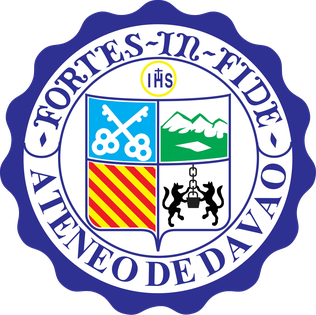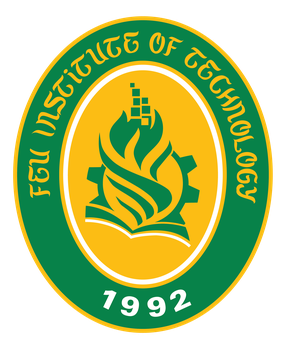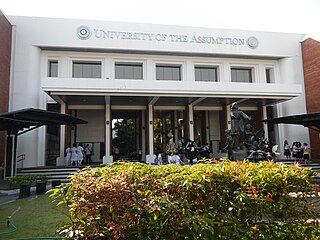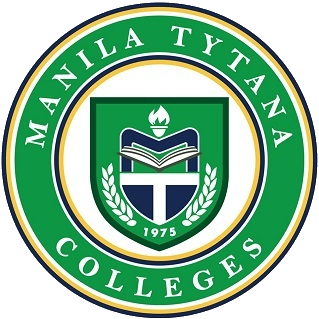The Xavier University – Ateneo de Cagayan, also known simply as the Ateneo de Cagayan or Xavier is a private, Catholic, coeducational, basic and higher education institution. It is operated by the Philippine Province of the Society of Jesus in Cagayan de Oro, Misamis Oriental, Philippines. Founded in 1933 as the Ateneo de Cagayan, it became the first higher education institution in Mindanao to receive a university status a year before its sister school Ateneo de Manila. It was given its present name in honor of the Jesuit missionary St. Francis Xavier.

The University of Evansville (UE) is a private university in Evansville, Indiana. It was founded in 1854 as Moores Hill College. The university operates a satellite center, Harlaxton College, in Grantham, England. UE offers more than 80 different majors and areas of study, each housed within three colleges and one school within the university: the Schroeder School of Business, the College of Education and Health Sciences, the College of Engineering and Computer Science, and the William L. Ridgway College of Arts and Sciences. The school is affiliated with the United Methodist Church.

Ateneo de Davao University is a private Catholic basic and higher education institution run by the Philippine Province of the Society of Jesus in Davao City, Davao del Sur, Philippines. It was established in 1948 when the Jesuits took over the administration of the diocesan school, St. Peter's Parochial School. The Jesuits renamed the school to "Ateneo de Davao" after taking control. At that time, the Jesuits named all the schools that they were opening "Ateneo." Ateneo de Davao is the seventh school in the country to be named as Ateneo by the Jesuits. The university has five undergraduate schools, namely the School of Arts and Sciences, School of Business and Governance, School of Engineering and Architecture, School of Education and the School of Nursing. The graduate programs are under these units as well. The College of Law is a separate unit within the university. The university also runs a grade school and high school, both Junior High and Senior High.

The University of the East, also known as UE, is a private university located in Manila, Philippines. Founded in 1946, business tycoon Lucio Tan acquired the university in 1990. UE was once labeled as the "largest university in Asia" when its enrollment in the past reached over 65,000 students.

Mapúa University, also known simply as Mapúa or MU, is a private research-oriented non-sectarian university located in Metro Manila, Philippines. The university was founded in 1925 by the first registered Filipino architect, Tomás Mapúa, a graduate of Cornell University in New York, US. In 2000, the university was acquired by the Yuchengco Group of Companies.

FEU Institute of Technology, also referred to as FEU Tech, is a private, non-sectarian, coeducational higher education institution in Sampaloc, Manila, Philippines. It offers courses in the fields of Engineering and Computer Studies. Established in 1992 as East Asia Computer Center, Inc.(EACCI), an educational partnership of Asia Pacific Computer Technology Center, Intelligent Wave Inc., and Far Eastern University.

The Emilio Aguinaldo College is a private university based in Manila, Philippines.

The University of Caloocan City is a public-type local university established in 1971 and formerly called Caloocan City Community College and Caloocan City Polytechnic College. Its south campus is located at Biglang Awa Street, Grace Park East, 12th Avenue, Caloocan, Metro Manila, Philippines and the north campuses are Camarin Business Campus, Congressional Campus, and Bagong Silang Campus.

The University of the Assumption (U.A.) is a private archdiocesan Catholic university in the City of San Fernando, Pampanga, Philippines. The University of the Assumption is the first Catholic archdiocesan university in the Philippines and in Asia. It is among the top schools in the region, based on its accredited programs, and licensure and professional examination results.

Manila Tytana Colleges (MTC), or just simply Tytana, the educational arm of the Metrobank group, is a private college in Pasay, Philippines..
The University of the East - College of Business Administration was founded as the mother unit of the University of the East, starting from Philippine College of Commerce and Business Administration (PCCBA) in 1946. UE is one of the pioneers of business education in the Philippines and is considered one of the best accounting schools, especially from its founding up to the 1980s, when UE graduates would dominate the topnotchers list of the CPA board exams. The College is both offered in Manila and Caloocan.

The Divine Word College of Calapan, also referred to by its acronym DWCC, is a private Catholic basic and higher education institution in Calapan, Oriental Mindoro, Philippines. It is run by the Philippine Central Province of the Society of the Divine Word. It was established by the Divine Word Missionaries in April 1946 and was then called Mindoro Junior College until January 1981. The academic programs offered on its first year of operation were normal education, liberal arts, pre-law, including short term courses in typing and stenography.
The University of the East College of Computer Studies and Systems offered a baccalaureate degree in Computer Science in the University Belt area starting in the year 1988. Presently, the Commission on Higher Education (CHED) has identified the University of the East as a Center of Excellence in Information Technology Education.

The Eulogio "Amang" Rodriguez Institute of Science and Technology is a public college in Santa Mesa, Manila in the Philippines. It was named after Eulogio Rodriguez, one of the longest serving senators in the country.
Philippine Cultural College is a Chinese Filipino school with three campuses located in Manila, Caloocan and Quezon City, Metro Manila, Philippines, established on June 27, 1923 by the Philippine Chinese Educational Association. PCC is the oldest Chinese Filipino secondary school in the Philippines. It is a non-stock, non-profit, and non-sectarian co-educational education institution offering pre-school, and has a Level II re-accredited status from the Philippine Accrediting Association of Schools, Colleges and Universities (PAASCU) for its grade school and high school. Its programs emphasize in the English, Filipino, and Mandarin Chinese languages, Mathematics, Science, and Information Technology.

The Polytechnic University of the Philippines is a coeducational state university in Manila, Philippines. It was founded on 19 October 1904, as the Manila Business School (MBS) and as part of Manila's public school system. It was eventually promoted to a chartered state university in 1978, by virtue of Presidential Decree 1341. PUP has more than 20 Campuses across Central Luzon, Southern Luzon and Metro Manila. With over 80,000 enrolled students, PUP claims to be the largest state university in the Philippines by student population.

Baliuag University is a private university in the Philippines. It was founded in 1925 and was the first school granted full autonomy in Central Luzon by the Commission on Higher Education. It was founded in 1925 by Domingo “Tatang” Santiago. Sr, as the Baliuag Institute.

Far Eastern University, also referred to by its acronym FEU, is a private research non-sectarian university in Manila, Philippines. Created by the merger of Far Eastern College and the Institute of Accounts, Business and Finance, FEU became a university in 1934 during the term of its first president, Nicanor Reyes Sr.
Arellano University operates seven campuses in Metro Manila.

Notre Dame of Kidapawan College, also referred to by its acronym NDKC, is a private, Catholic basic and higher education institution run by the Marist Brothers of the Schools or FMS (Fratres Maristae a Scholis), a Catholic religious order from France. It was founded by Bishop Gerard G. Mongeau, OMI, DD in 1948. It offers elementary, high school, undergraduate and postgraduate courses (in consortium with NDDU and independent program). It is located in Kidapawan City, Cotabato, Philippines. NDKC has been a member of the Notre Dame Educational Association, a group of schools named Notre Dame in the Philippines which is under the patronage of the Blessed Virgin Mary.






















